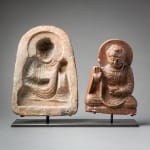Seated Buddha Mould, with Impression, 2nd Century CE - 5th Century CE
Terracotta
14.4 x 18.5 cm
5 5/8 x 7 1/4 in
5 5/8 x 7 1/4 in
SF.068
This small terracotta mould was used to produce impressions of the seated Buddha. The right hand is raised with the palm facing outwards in a gesture of reassurance or blessing....
This small terracotta mould was used to produce impressions of the seated Buddha. The right hand is raised with the palm facing outwards in a gesture of reassurance or blessing. The left hand holds an alms bowl, a symbol of the monastic life, just below the chest. The head tilts forward slightly from the halo and the gaze is directed downwards. The impressions would have been highly portable and were probably used in private devotion by monks, lay people or travelling pilgrims. Although moulds of this kind would have been common during the early centuries of Buddhism, they very rarely survive. This piece offers a rare glimpse of the ritual paraphernelia employed during the early centuries of Buddhism.
For a similar example see, The Art of Gandhara in the Metropolitan Museum of Art,(New York, 2007), p. 75, no. 57.
For a similar example see, The Art of Gandhara in the Metropolitan Museum of Art,(New York, 2007), p. 75, no. 57.



